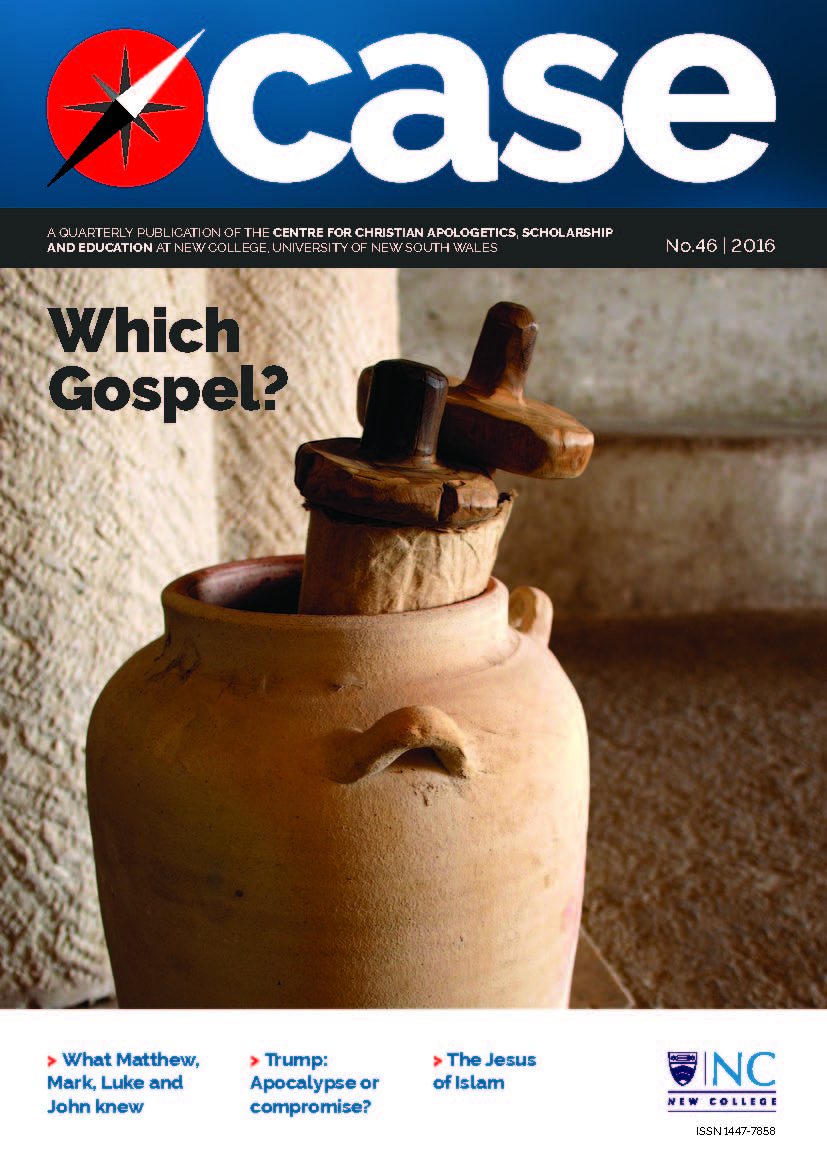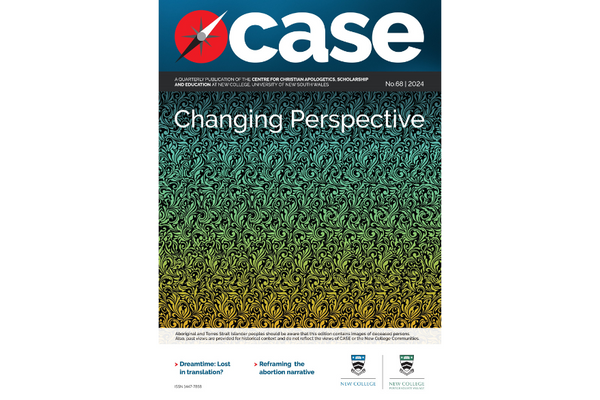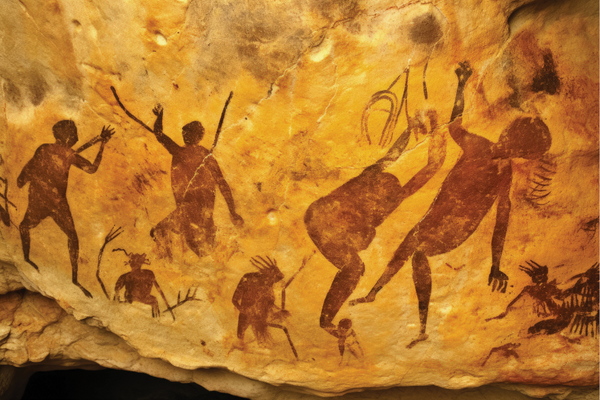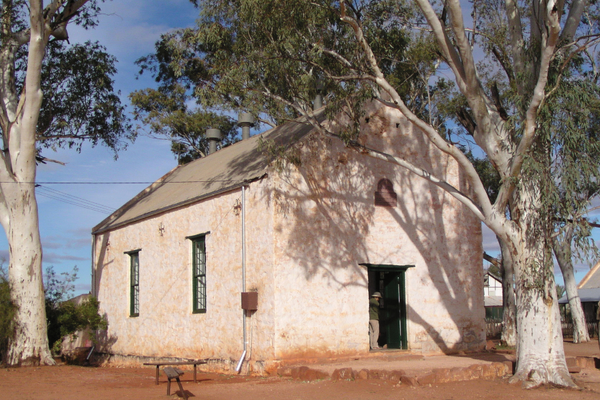Which Gospel?: Introduction

Trevor Cairney
Welcome to this latest edition of Case Quarterly, our 46th since it began in 2002. Sadly, this is my last issue as Editor and Director. It has been my great privilege to lead CASE since its inception and to be part of the team that has developed it into the significant ministry that it is today. This final column will serve as the usual introduction to the issue, as well as a retrospective on 15 years of CASE.
A new format
I hope that you like our changes to Case, which is the first full revision of the publication since Issue 1 in 2002. So, you might say, it’s about time! Associated with the new look is both a new mix of content in the quarterly, and a relaunch of our CASE website which provides a new way to access CASE resources. If you haven’t checked out the new website, please do so as it is a significant departure from the previous version.
We’ve been thinking about these changes for almost three years, and working on some of them for almost two! While funding is always a problem, our staff have been able to do most of what we have needed to do. As well, our independent designer Joy Lankshear has been working on all aspects of design with us. I want to thank Jonathan Billingham, who is the College Public Relations Manager, and has been responsible for most of the key design elements of the website, as well as contributing many hours populating it with content. He has also led the redesign of the content management system on the CASE website. He has been well assisted in these tasks by Emma Nelson in our public relations team, and Dani Scarratt my Co-editor. Edwina Hine has also been an invaluable support in varied ways. The changes have been a wonderful team effort. I hope that you enjoy and benefit from them.
Accessing CASE content
With our new look Case Quarterly, and redesigned website, we now offer a variety of options for accessing old and new content, whether articles from Case Quarterly, reviews, or special publications. Every one of our in-depth articles from past and current issues of Case is now on the site. There is a range of new subscription options for individuals, churches and other institutions. Print subscriptions are still available, or by choosing a digital subscription (digital only or print + digital) subscribers can have access to all content on the website. Non-subscribers can access all free content, and purchase individual articles for a small fee. You can explore all of these options at www.case.edu.au.
A new segment
Case in Point is a new segment in the journal written by regular and guest columnists. The aim of the segment is to provide readers with brief but thought-provoking reflection and analysis by Christian thinkers in a range of areas of life and thought. The format also allows columnists to bring a biblical perspective to bear on developments in their area of expertise and alert readers to new challenges and resources as they seek to live out their faith and share it with their neighbours.
Case Quarterly Issue 46
The theme of the current issue of Case is ‘Which Gospel?’ We live in an age where people are prone to make snap judgments. We can be quick to give allegiance to various causes, to make people heroes for, at times, modest reasons, and to dismiss ideas with little consideration of the evidence in support of them. Attitudes to Jesus in this age vary widely. Some accept that he lived, some even see him as a great person in history. But was he a prophet, priest or king? Or, to paraphrase C.S. Lewis, a lunatic, liar or Lord? The evidence for just who Jesus was and is, comes primarily from the Bible’s Old and New Testaments. Archaeology, Jewish literature and secular texts also provide historical evidence that Jesus lived. But who was he? There are other faiths that have an opinion on who Jesus was, and competing gospels that were not included in our Bible. So, which gospels do we believe? This was the broad topic for the 2016 New College Lectures delivered by Dr Simon Gathercole, and the long article we include is based on one of his talks.
Dr Gathercole contrasts the biblical gospels—Matthew, Mark, Luke and John—with a number of non-biblical gospels, including the Gospel of Judas and the Gospel of Thomas. He finds a significant divergence between attitudes to the Old Testament in the two sets of writings about the life of Jesus. Whereas the New Testament gospels go out of their way to portray Jesus as fulfilling existing Jewish Scriptures, the apocryphal gospels largely sideline—or even expurgate—Jesus’ relationship to these texts. The texts include many errors and inconsistencies and the Jesus they present is therefore disconnected from this heritage, and they reflect various other philosophies.
Samuel Green explains another perspective on Jesus. Like Christians, people of Islamic faith also believe that Jesus existed. But what they believe is derived from their key religious text. The Qur’an was written in the context of knowledge of the Judeo-Christian Scriptures, and claims continuity with these, unlike the apocryphal gospels that Gathercole examines. Islam therefore has a story to tell about Jesus that purports to fit with the framework of Jewish and Christian texts. It is this story that Green explores in his article ‘The Gospel According to Muhammad’. However, the Jesus we see in the Qur’an is, in important ways, not the Jesus of the New Testament. Green explains what some of these differences are, addresses why they are there, and explains the contradictions they contain.
CASE: A Retrospective
The Centre for Apologetic Scholarship & Education (CASE) commenced in 2002 when I arrived that year as the 5th Master of New College. Dr Greg Clarke was my first appointment as full-time Director of the Centre in 2003. We worked in partnership to develop the centre and its varied activities, including Case Magazine. Greg was the driving force in those early years, shaping the structure of Case Magazine that we’ve renamed Case Quarterly in recent years. While we’ve made changes to Case over the years, the original philosophy behind the publication and its purposes have changed little. Of course, Case Magazine is just one of the activities of the CASE centre. In Greg’s first year he started meetings for young scholars, ran workshops, seminars and forums and drew in an ever-widening group of people. Greg established a young scholars’ group, mentored young Christian residents at New College, and helped to establish a network of Christian scholars. However, eventually it proved difficult to sustain a full-time director and Greg moved on to other opportunities.
In 2007 I took over as the Director of CASE and Editor of Case Quarterly. While it was impossible to continue the many activities we ran under a full-time director, we managed to continue several. I established an Editorial Committee to offer advice on Case Quarterly and this acted as a valuable community of scholars. I also commenced regular quarterly discussion seminars as each issue of Case was released, and of course, we have continued to mount major conferences and seminars.
While CASE has done many things, Case Quarterly has been the intellectual flagship of our work. Our first edition, while similar in appearance to later editions, had just 16 pages. This was to grow to the customary 32-page format over the years.
Right from the first issue, we were keen to make Case different to most serious publications in apologetics or public theology. Stunning images were used to add semiotic value and interest to each edition. Part of this has been the choice of multi-dimensional cover images, capable of more than one interpretation. I have some favourites, including issue 3 on ‘The Fate of Witchcraft’ with its image of a witch on broomstick wrapped around a telegraph pole – an unfortunate accident! Issue 20, ‘To Give a Reason’ had an image of a chicken next to an egg, prompting the obvious question. Our very first issue in 2002 on ‘Just War or Just Aggression’ had a challenging image of a shattered bullet-ridden sheet of glass, with three frightened faces peering through, at the time of the War in Iraq. ‘God Beyond Borders’ in 2010 used a map of the globe superimposed across a face, and ‘Formative Education’ in 2012 carried an image of a hand holding a head moulded from clay. Inside each magazine we also use evocative images that add to the reading experience.
But ultimately, the words are where Case Quarterly has challenged and informed the most. Our writers have included such well-known Australian theologians and public intellectuals as Paul Barnett, Greg Clarke, Tom Frame, Kirsten Birkett, Andrew Cameron, John McLean, David Höhne, Andrew Sloane, Gordon Preece, Megan Best, Michael Jensen, David Starling, Bruce Kaye, Peter Adam, Edwin Judge, Graeme Goldsworthy, Ross Clifford, Andrew Shead and Rhys Bezzant. We have also given many young Australian Christian writers their first opportunity to publish.
As well, we have invited scholars from around the world to write, and have featured work from some of the world’s leading theologians. These have included Alister McGrath, Oliver O’Donovan, Trevor Hart, John Wyatt, Tim Chester, Stanley Hauerwas, Jeremy Begbie, James K.A. Smith, John Polkinghorne, and John Stackhouse.
What a privilege it has been to run a ministry like CASE that has been of benefit to so many people. But it has also been a professional and spiritual development program for me and others who have worked on it, as much as our readers. The experience of leading CASE has been a ‘stretching’ one personally, forcing me to read well beyond my chosen field.
Over the years, I have had a series of wonderful co-editors who have worked with me on Case, as well as various staff at New College who have taken on other duties. The Co-editors since I took over as Director of CASE have included Roberta Kwan, Mike Thompson, Chris Swann and Dani Scarratt. Dani has been the longest serving Co-editor (for issues 23 to 46). It has been a joy to work with her as an editor and scholar. We’re pleased with the work that we’ve done across these varied issues and have been pleased to see a number of articles given awards by the Australian Religious Press Association (ARPA)
Events and conferences have also been an important part of what we’ve done at CASE. Conferences have included ‘Faithful Writers’ in 2008 in partnership with Matthias Media; a conference on medical ethics entitled ‘Life’s End’ in 2010 with Dr John Wyatt; ‘Formative Education’ with keynote speaker James K.A. Smith in 2012; and ‘Powerful Words’ in partnership with Anglicare in 2015. There have also been numerous seminars run by CASE on varied topics, and in association with organizations like ISCAST with whom we have had a long partnership.
Departure from CASE
As I said above, this is my last issue as Editor of Case Quarterly and Director of CASE. I’m pleased that I can leave CASE and Case Quarterly in great shape, and in good hands. I will continue to have an ongoing interest in CASE as a member of the Editorial Committee, and also as a Case columnist writing about education, families and work.
My future, post-New College, is what some of my friends call a ‘portfolio career’. I think the Apostle Paul—as preacher, teacher, tent maker and public activist—might just call it ministry. I want to wish Associate Professor Bill Peirson all the best in his role as the new Master of New College and Director of CASE. I look forward to continuing to support the work of CASE and Case Quarterly in the future.
Leave a comment
Comments will be approved before showing up.



